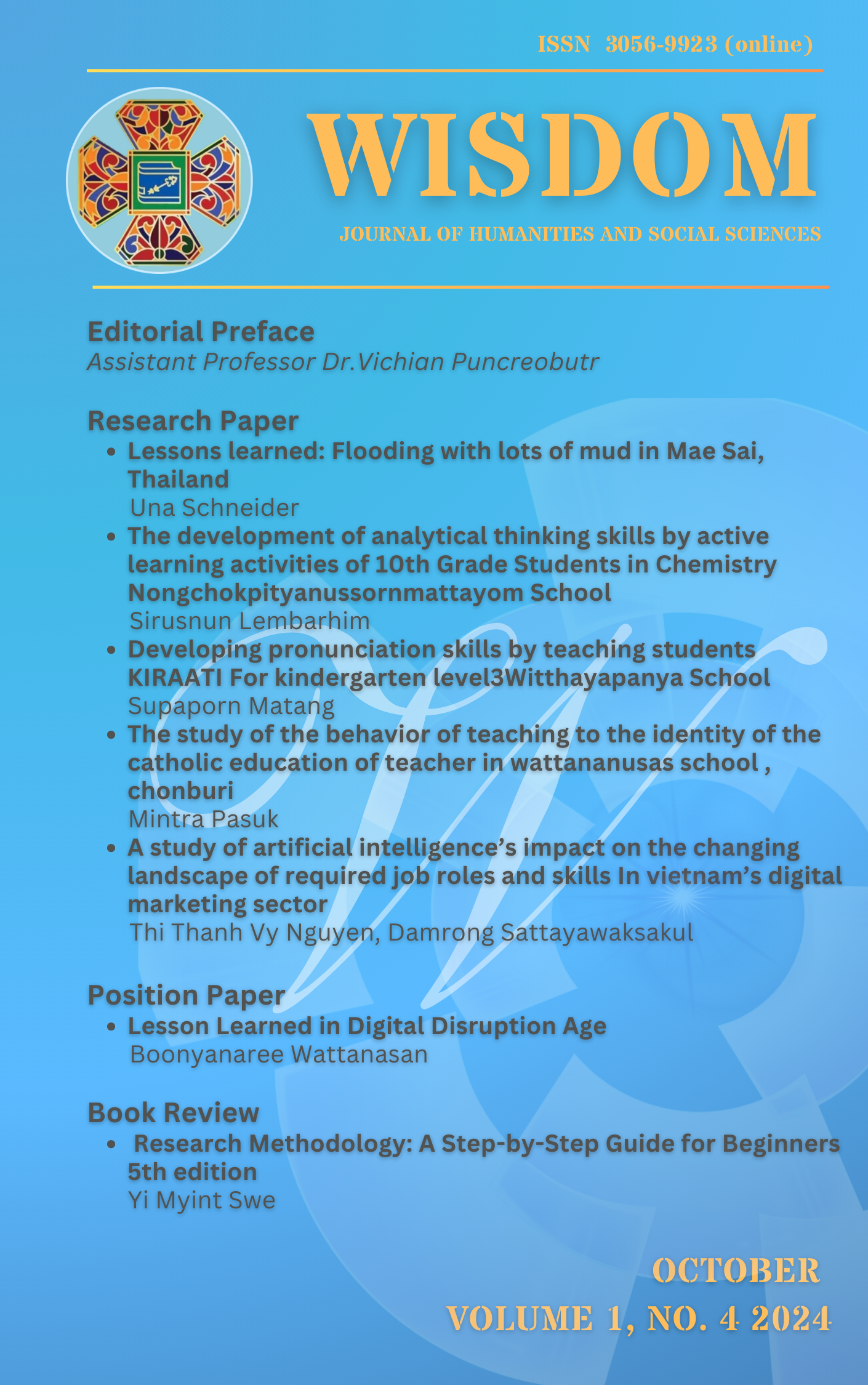Lessons learned: Flooding with lots of mud in Mae Sai, Thailand
Keywords:
Lessons learned from the flood, Flooding with a lot of sediment, Flood knowledge managementAbstract
This research is a qualitative research. The purpose of this research is to extract lessons from the flood with a large amount of mudslides in Mae Sai District, Thailand. The sample group or the recipients of lessons learned consisted of those responsible for meteorology, those responsible for forestry, those responsible for flooding, those involved in geographic information, and those involved in emergency management in Mae Sai District, Chiang Rai Province, totaling 30 key informants. The selection of key informants was done using the snowball technique. The researcher collected data on-site using the methods of participant observation, non-participant observation, and in-depth interviews with the sample group. The results were then analyzed using the content analysis technique. The results of the study found that 1) the main factor causing floods was heavy rain in the area continuously for a long time, both in Mae Sai District, Thailand, and Tachileik District, Myanmar. 2) the main factor of a large amount of mudslides flowing with water was found to have large landslides in many areas in areas with rainfall in both countries. 3) the lesson learned is that the Sai River is a river that separates Thailand and Myanmar. While each country has its own specific data for decision-making, such as rainfall data and water volume flowing into the Sai River Information on forest areas at risk of landslides/soil collapse/landslides, etc., which resulted in a greater amount of muddy water flowing into the community than expected.
References
กรมป้องกันและบรรเทาสาธารณภัย. (2015). แผนป้องกันและบรรเทาสาธารณภัยแห่งชาติ พ.ศ. 2558. กรุงเทพฯ: กรม ป้องกันและบรรเทาสาธารณภัย กระทรวงมหาดไทย.
กระทรวงสาธารณสุข. (2024). รายงานการติดตามสถานการณ์. สืบค้นเมื่อ 17 กันยายน 2024 จาก https://plancro.moph.go.th/subphem
กาญจน์ชนิษฐา เอกแสงศรี. (2558). ภาวะผู้นำในการจัดการวิกฤติและกลยุทธ์การบริหารจัดการน้ำเพื่อ บรรเทา ภัยพิบัติ สำหรับความมั่นคงของมนุษย์ยุคใหม่: กรณีศึกษาจังหวัดในพื้นที่ลุ่มน้ำภาคกลางของ ประเทศ ไทย. วารสารรัฐศาสตร์รีวิวมหาวิทยาลัยเกษตรศาสตร์, 2(1), 97-110.
เทศบาลนครเชียงราย. (2024). รายงานสรุปสถานการณ์น้ำท่วมในเขตเทศบาลนครเชียงราย. สืบค้นเมื่อ 17 กันยายน 2024 จาก https://www.chiangraicity.go.th/data
ปุณิกา พรานพนัส และสุวรรณี แสงมหาชัย. (2563). การจัดการอุทกภัยในภาวะวิกฤตของไทย. วารสารรัชต์ภาคย์. 14(36), 68-79.
สำนักงานสภาพัฒนาการเศรษฐกิจและสังคมแห่งชาติ. (2016). แผนบริหารจัดการน้ำและพืชผลทางการ เกษตร: ภาวะเศรษฐกิจไทยไตรมาสแรกของปี 2016 และแนวโน้มปี 2016. สืบค้นจาก https://www.nesdc.go.th/ewt_news.php?nid=5856&filename=index
สุริชัย หวันแก้ว และคณะ. (2007). สังคมวิทยาสึนามิ: ระบบการรับมือภัยพิบัติ. กรุงเทพฯ: สถาบันวิจัย สังคม จุฬาลงกรณ์มหาวิทยาลัย.
อุทัย เลาหวิเชียร และ สุวรรณี แสงมหาชัย. การจัดการป้องกันและบรรเทาอุทกภัยในเขตกรุงเทพมหานคร. วารสารมหาวิทยาลัยเกษมบัณฑิต, 18(2), 111-127.
Aeksaengsee, K. (2015). The Crisis Management Leadership and Disaster Mitigation Water Management Strategy for the Modern Human Security: A Case Study of the Provinces in The Flood-Plane Areas of Central Thailand. Political Science Review Journal, Kasetsart University, 2(1), 97-110. [In Thai]
Chiang Rai Municipality. (2024). Summary report of flood situation in Chiang Rai Municipality. Retrieved September 17, 2024 from https://www.chiangraicity.go.th/data [In Thai]
Laohawichian, U., and Sangmahachai, S. (2017). Flood Prevention and Mitigation Management in Bangkok Metropolis. Kasem Bundit Journal, 18(2), 111-127. [In Thai]
Ministry of Public Health. (2024). Situation monitoring report. Retrieved September 17, 2024 from https://plancro.moph.go.th subphem. [In Thai]
Pranpanus, P. & Sangmahachai, S. (2020). Management of Flood Crisis of Thailand. Rajapark
Journal. 14(36): 68-79. [In Thai]
Wankaew, S. et al. (2007). Tsunami Sociology: Disaster Response System. Bangkok: Social
Research Institute, Chulalongkorn University [In Thai]
Wattanasan, P., & Puncreobutr, V. (2021). Conceptual Framework for Transferring Lessons Learned from Work for The Development of Best Practices. Turkish Online Journal of Qualitative Inquiry. 12 (7), 4848-4856.





